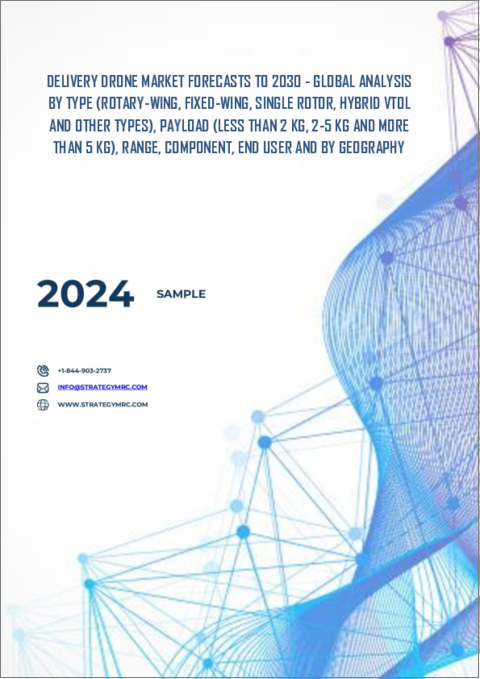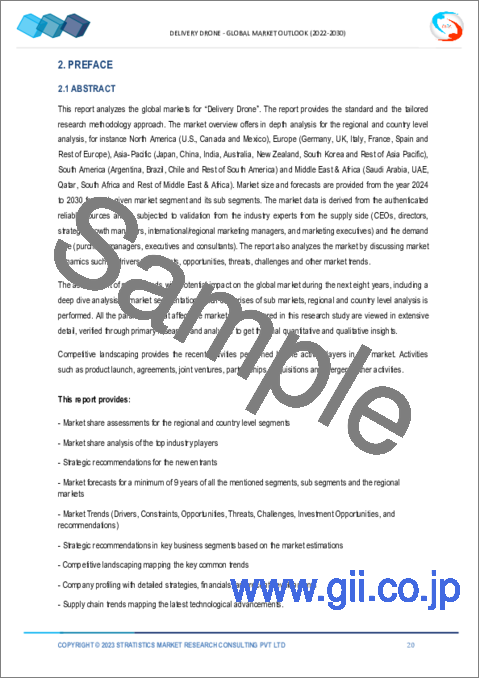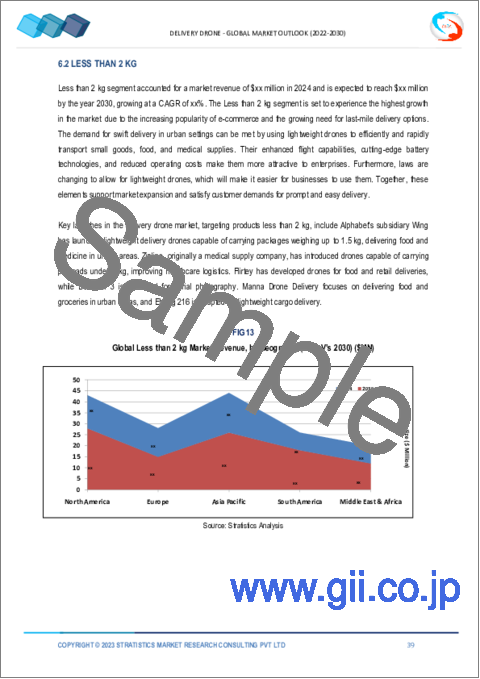|
|
市場調査レポート
商品コード
1511290
配送用ドローンの2030年までの市場予測: タイプ別、ペイロード別、航続距離別、コンポーネント別、エンドユーザー別、地域別の世界分析Delivery Drone Market Forecasts to 2030 - Global Analysis By Type (Rotary-Wing, Fixed-Wing, Single Rotor, Hybrid VTOL and Other Types), Payload (Less than 2 kg, 2-5 kg and More than 5 kg), Range, Component, End User and by Geography |
||||||
カスタマイズ可能
|
|||||||
| 配送用ドローンの2030年までの市場予測: タイプ別、ペイロード別、航続距離別、コンポーネント別、エンドユーザー別、地域別の世界分析 |
|
出版日: 2024年07月06日
発行: Stratistics Market Research Consulting
ページ情報: 英文 200+ Pages
納期: 2~3営業日
|
全表示
- 概要
- 図表
- 目次
Stratistics MRCによると、世界の配送用ドローン市場は2024年に8億3,106万米ドルを占め、2030年には68億5,091万米ドルに達すると予測され、予測期間中のCAGRは42.13%で成長する見込みです。
ドローンによる配送は、商品の輸送方法を変革し、玄関先まで迅速かつ効率的に荷物を届ける未来への窓を提供しています。これらの無人航空機(UAV)は、障害物回避システムやGPSナビゲーションを含む高度な技術により、複雑な環境を容易に航行することができます。
迅速な配送サービスへのニーズの高まり
配送用ドローンの需要は、オンデマンドサービスの台頭と即座の満足感への期待によって煽られている、迅速な配送ソリューションに対する消費者のニーズの高まりによって牽引されています。これらのドローンは、配送時間を大幅に短縮し、企業と顧客双方の需要の変化に対応することが期待されています。ドローン配送インフラへの投資は、迅速な配送オプションが提供する競争上の優位性を認識する企業が増えるにつれて急増しています。
空域の規制と安全性の問題
ドローンの空域への統合には規制当局のサポートが必要だが、厳しい規制と安全上の懸念が配送用ドローンの普及を大きく妨げています。空域、飛行高度、プライバシーの制限を含む、ドローンの運用を管理する複雑な法的枠組みは、ドローン配送サービスの成長と展開を困難にする可能性があります。さらに、ドローン操縦者のための規制環境は、空中衝突、ドローンの故障、有人航空機への潜在的な脅威に関する安全上の懸念によってさらに複雑になっており、これらすべてが、従うべき厳格な航空基準と強力な安全予防措置を求めています。
遠隔地や農村部へのアクセス
ドローンによる配送は、従来の輸送ネットワークでは十分なサービスを受けられない遠隔地や農村部での商品やサービスへのアクセスを拡大する、画期的な機会を記載しています。ドローンは、道路へのアクセスが悪かったり、地形的に困難な地域に食料、医薬品、人道支援などの必需品を輸送する経済的で効果的な手段を記載しています。さらにドローンは、地理的な障壁を取り除き、配送時間を短縮し、包括的な成長と開発を促進することで、遠隔地の地域社会の生活水準と経済機会を向上させる可能性を秘めています。
空域の過密化と複雑な規制
配送用ドローンの普及は、特に空域がすでに多用されている人口密度の高い都市部では、規制を複雑にし、空域を混雑させる恐れがあります。ドローンの交通が適切に制御されない場合、交通渋滞や有人航空機を巻き込む事故、安全リスクの増大を招く恐れがあります。また、ドローンオペレーターにとって大きな障害となるのは、プライバシー、飛行許可、空域の制限など、ドローンの運用に関わる複雑な法律や規制の網の目をかいくぐることです。さらに、コンプライアンス要件が満たされず、航空当局から必要な許可を得られない場合、ドローン配送サービスの規模を拡大したり、拡大したりすることができない可能性があります。
COVID-19の影響:
配送用ドローンの市場は、COVID-19の大流行により、プラスにもマイナスにも大きな影響を受けています。ドローンによる配送サービスは、eコマースの増加や、ロックダウン中の非接触型配送オプションの需要の結果、人気が高まっています。企業は、人との接触を最小限に抑えながら、ドローン配送サービスに対する需要の高まりに応える創造的な方法を模索しています。パンデミックによって、強固なサプライチェーンとラストワンマイルの配送オプションの必要性が強調された結果、ドローン技術はさらに普及しています。しかし、パンデミックは、サプライチェーンや製造の混乱、規制措置の遅れ、経済の不確実性などの困難ももたらしており、これらすべてが市場の拡大や一部地域でのドローン配送プロジェクトの実行を遅らせています。
予測期間中、ハイブリッドVTOLセグメントが最大となる見込み
配送用ドローン市場では、ハイブリッドVTOL(垂直離着陸)ドローンが最大の市場シェアを占めています。他の配送用ドローンタイプと比較して、ハイブリッドVTOLドローンは、固定翼機と回転翼機の両方の利点を組み合わせることで、より高い汎用性、効率性、より長い航続距離を記載しています。これらのドローンは、その垂直離着陸能力により、狭い場所や都市環境での運用が可能です。さらに、前方飛行に切り替えて効果的な長距離配送任務を遂行することもできます。
予測期間中にCAGRが最も高くなると予想されるのはバッテリーセグメント
配送用ドローン市場では、バッテリーセグメントが最も高いCAGRで成長しています。エネルギー密度の向上、充電時間の短縮、飛行時間の延長といったバッテリー技術の発展により、配送用ドローンはより遠くまで移動し、より大きな荷物を輸送できるようになりました。これらの開発は、バッテリーセグメントの爆発的成長の主要原動力となっています。配送用ドローンは現在、軽量でエネルギー密度が高く、充電可能であることから、特にリチウムイオン電池の使用を好んでいます。さらに、バッテリーの性能、信頼性、安全性の向上を目指した研究開発の取り組みも、配送用ドローン市場におけるバッテリーセグメントの成長を後押ししています。
最大のシェアを持つ地域
北米は、洗練された技術インフラ、寛大な規制環境、物流とeコマースの広範な利用により、配送用ドローン市場を独占しています。同地域の優位性は特に米国で顕著であり、Amazon、UPS、AlphabetのWingのような組織によって大規模な試験や商用ドローン配送が実施されています。さらに、米連邦航空局(FAA)がドローンの法律を簡素化し、空域への安全な統合を奨励する取り組みを行っていることも、北米における配送用ドローン市場の拡大に有利な雰囲気を作り出しています。
CAGRが最も高い地域:
配送用ドローン市場は、欧州で最も高いCAGRで成長する見込みです。都市化の進展、迅速な配送サービスに対する消費者の需要、ドローンの運用を促進する規制の枠組みなど、多くの要因が同地域の成長を後押ししています。英国、ドイツ、フランスなどの国々では、ドローン技術のインフラや研究に多額の投資が行われており、これがイノベーションと配送用ドローンソリューションの商業化を促進しています。さらに、加盟国間でドローン法を標準化し、ドローンの安全な空域への統合を奨励するEUの取り組みが、市場の拡大をさらに後押ししています。
無料のカスタマイズ提供:
本レポートをご購読のお客様には、以下の無料カスタマイズオプションのいずれかをご提供いたします。
- 企業プロファイル
- 追加市場参入企業の包括的プロファイリング(最大3社まで)
- 主要企業のSWOT分析(3社まで)
- 地域セグメンテーション
- 顧客の関心に応じた主要国の市場推定・予測・CAGR(注:フィージビリティチェックによる)
- 競合ベンチマーキング
- 製品ポートフォリオ、地理的プレゼンス、戦略的提携別の主要企業のベンチマーキング
目次
第1章 エグゼクティブ概要
第2章 序文
- 概要
- ステークホルダー
- 調査範囲
- 調査手法
- データマイニング
- データ分析
- データ検証
- 調査アプローチ
- 調査情報源
- 1次調査情報源
- 2次調査情報源
- 前提条件
第3章 市場動向分析
- イントロダクション
- 促進要因
- 抑制要因
- 機会
- 脅威
- エンドユーザー分析
- 新興市場
- COVID-19の影響
第4章 ポーターのファイブフォース分析
- 供給企業の交渉力
- 買い手の交渉力
- 代替品の脅威
- 新規参入業者の脅威
- 競争企業間の敵対関係
第5章 世界の配送用ドローン市場:タイプ別
- イントロダクション
- 回転翼
- 固定翼
- シングルローター
- ハイブリッドVTOL
- その他
第6章 世界の配送用ドローン市場:ペイロード別
- イントロダクション
- 2kg以下
- 2~5kg
- 5kg以上
第7章 世界の配送用ドローン市場:航続距離別
- イントロダクション
- 25km以下
- 25km以上
第8章 世界の配送用ドローン市場:コンポーネント別
- イントロダクション
- 推進システム
- 機体
- コントローラーシステム
- バッテリー
- カメラ
- ナビゲーション
- その他
第9章 世界の配送用ドローン市場:エンドユーザー別
- イントロダクション
- コンビニエンスストア
- eコマース
- クイックサービスレストラン
- 小売・物流
- 飲食品
- 医療
- 工業と貨物
- その他
第10章 世界の配送用ドローン市場:地域別
- イントロダクション
- 北米
- 米国
- カナダ
- メキシコ
- 欧州
- ドイツ
- 英国
- イタリア
- フランス
- スペイン
- その他の欧州
- アジア太平洋
- 日本
- 中国
- インド
- オーストラリア
- ニュージーランド
- 韓国
- その他のアジア太平洋
- 南米
- アルゼンチン
- ブラジル
- チリ
- その他の南米
- 中東・アフリカ
- サウジアラビア
- アラブ首長国連邦
- カタール
- 南アフリカ
- その他の中東・アフリカ
第11章 主要開発
- 契約、パートナーシップ、コラボレーション、合弁事業
- 買収と合併
- 新製品発売
- 事業拡大
- その他の主要戦略
第12章 企業プロファイリング
- Zomato
- Uber Technologies Inc.
- Amazon.com Inc.
- Domino's Pizza Inc.
- FedEx Corporation
- Deutsche Post DHL Group
- Zipline International Inc.
- Airbus SE
- Skycart Inc
- The Boeing Company
- Alphabet Inc.
- Matternet Inc.
- Wing Aviation LLC
- Drone Delivery Canada Corp.
- Workhorse Group Inc.
List of Tables
- Table 1 Global Delivery Drone Market Outlook, By Region (2022-2030) ($MN)
- Table 2 Global Delivery Drone Market Outlook, By Type (2022-2030) ($MN)
- Table 3 Global Delivery Drone Market Outlook, By Rotary-Wing (2022-2030) ($MN)
- Table 4 Global Delivery Drone Market Outlook, By Fixed-Wing (2022-2030) ($MN)
- Table 5 Global Delivery Drone Market Outlook, By Single Rotor (2022-2030) ($MN)
- Table 6 Global Delivery Drone Market Outlook, By Hybrid VTOL (2022-2030) ($MN)
- Table 7 Global Delivery Drone Market Outlook, By Other Types (2022-2030) ($MN)
- Table 8 Global Delivery Drone Market Outlook, By Payload (2022-2030) ($MN)
- Table 9 Global Delivery Drone Market Outlook, By Less than 2 kg (2022-2030) ($MN)
- Table 10 Global Delivery Drone Market Outlook, By 2-5 kg (2022-2030) ($MN)
- Table 11 Global Delivery Drone Market Outlook, By More than 5 kg (2022-2030) ($MN)
- Table 12 Global Delivery Drone Market Outlook, By Range (2022-2030) ($MN)
- Table 13 Global Delivery Drone Market Outlook, By Less than 25 km (2022-2030) ($MN)
- Table 14 Global Delivery Drone Market Outlook, By More than 25 km (2022-2030) ($MN)
- Table 15 Global Delivery Drone Market Outlook, By Component (2022-2030) ($MN)
- Table 16 Global Delivery Drone Market Outlook, By Propulsion System (2022-2030) ($MN)
- Table 17 Global Delivery Drone Market Outlook, By Airframe (2022-2030) ($MN)
- Table 18 Global Delivery Drone Market Outlook, By Controller System (2022-2030) ($MN)
- Table 19 Global Delivery Drone Market Outlook, By Battery (2022-2030) ($MN)
- Table 20 Global Delivery Drone Market Outlook, By Camera (2022-2030) ($MN)
- Table 21 Global Delivery Drone Market Outlook, By Navigation (2022-2030) ($MN)
- Table 22 Global Delivery Drone Market Outlook, By Other Components (2022-2030) ($MN)
- Table 23 Global Delivery Drone Market Outlook, By End User (2022-2030) ($MN)
- Table 24 Global Delivery Drone Market Outlook, By Convenience Stores (2022-2030) ($MN)
- Table 25 Global Delivery Drone Market Outlook, By E-Commerce (2022-2030) ($MN)
- Table 26 Global Delivery Drone Market Outlook, By Quick-Service Restaurant (2022-2030) ($MN)
- Table 27 Global Delivery Drone Market Outlook, By Retail and Logistics (2022-2030) ($MN)
- Table 28 Global Delivery Drone Market Outlook, By Food and Beverages (2022-2030) ($MN)
- Table 29 Global Delivery Drone Market Outlook, By Healthcare (2022-2030) ($MN)
- Table 30 Global Delivery Drone Market Outlook, By Industrial and Cargo (2022-2030) ($MN)
- Table 31 Global Delivery Drone Market Outlook, By Other End Users (2022-2030) ($MN)
Note: Tables for North America, Europe, APAC, South America, and Middle East & Africa Regions are also represented in the same manner as above.
According to Stratistics MRC, the Global Delivery Drone Market is accounted for $831.06 million in 2024 and is expected to reach $6850.91 million by 2030 growing at a CAGR of 42.13% during the forecast period. Drone deliveries are transforming the way goods are transported and providing a window into the future of quick and efficient package delivery right to our doorsteps. These unmanned aerial vehicles (UAVs) can easily navigate complex environments owing to their advanced technology, which includes obstacle avoidance systems and GPS navigation.
Market Dynamics:
Driver:
Growing need for services with quicker delivery
Delivery drone demand is being driven by consumers increasing need for quick delivery solutions, which is being fueled by the rise of on-demand services and their expectation of instant gratification. These drones are expected to drastically cut delivery times, meeting the changing demands of both companies and customers. Investments in drone delivery infrastructure are surging as more businesses realize the competitive advantage that expedited shipping options offer.
Restraint:
Regulation of airspace and safety issues
The integration of drones into the airspace requires regulatory support, but strict regulations and safety concerns significantly impede the widespread use of delivery drones. The intricate legal framework that controls drone operations, which includes limitations on airspace, flight altitude, and privacy, can make it difficult for drone delivery services to grow and be deployed. Additionally, the regulatory environment for drone operators is further complicated by safety concerns pertaining to mid-air collisions, drone malfunctions, and potential threats to manned aircraft, all of which call for stringent aviation standards to be followed and strong safety precautions.
Opportunity:
Access to remote and rural areas
Drone deliveries offer a game-changing chance to expand access to goods and services in isolated and rural locations that are underserved by conventional transportation networks. Drones provide an economical and effective means of transporting necessities like food, medicine, and humanitarian aid to areas with poor road access or difficult topography. Moreover, drones have the potential to improve the standard of living and economic opportunities for communities in remote areas by removing geographical barriers, shortening delivery times, and promoting inclusive growth and development.
Threat:
Airspace overcrowding and complicated regulations
Delivery Drone proliferation threatens to complicate regulations and congest airspace, especially in densely populated urban areas where airspace is already heavily used. If drone traffic is not appropriately controlled, it may result in traffic jams, incidents involving manned aircraft, and increased safety risks. A major obstacle for drone operators can also be navigating the complicated web of laws and regulations governing drone operations, such as those pertaining to privacy, flight permits, and airspace restrictions. Additionally, drone delivery services may not be able to scale or expand if compliance requirements are not met and necessary permissions are not obtained from aviation authorities.
Covid-19 Impact:
The market for delivery drones has been significantly impacted by the COVID-19 pandemic, both positively and negatively. Drone delivery services have become more popular as a result of the rise in e-commerce and the demand for contactless delivery options during lockdowns. Businesses are looking for creative ways to meet the growing demand for drone delivery services while minimizing human contact. Drone technology is becoming even more popular as a result of the pandemic's emphasis on the need for robust supply chains and last-mile delivery options. However, the pandemic has also brought forth difficulties, including supply chain and manufacturing disruptions, delays in regulatory actions, and economic uncertainty, all of which have slowed down market expansion and the execution of drone delivery projects in some areas.
The Hybrid VTOL segment is expected to be the largest during the forecast period
In the delivery drone market, hybrid VTOL (Vertical Takeoff and Landing) drones command the largest market share. Compared to other delivery drone types, hybrid VTOL drones offer greater versatility, efficiency, and longer range capabilities by combining the advantages of both fixed-wing and rotary-wing aircraft. These drones can operate in cramped areas and urban settings owing to their vertical takeoff and landing capabilities. Moreover, they can also switch to forward flight to carry out effective long-range delivery missions.
The Battery segment is expected to have the highest CAGR during the forecast period
In the delivery drone market, the battery segment is growing at the highest CAGR. Developments in battery technology, such as increased energy density, quicker charging times, and extended flight times, have allowed delivery drones to travel farther and transport larger loads. These developments have been the main driver of the battery segment's explosive growth. Delivery drones now prefer to use lithium-ion batteries in particular because of their lightweight, high energy density, and rechargeable nature. Furthermore, the growth of the battery segment in the delivery drone market is also being driven by research and development initiatives aimed at enhancing battery performance, dependability, and safety.
Region with largest share:
North America dominates the delivery drone market due to its sophisticated technological infrastructure, benevolent regulatory environments, and extensive use of logistics and e-commerce. The region's dominance is especially noticeable in the US, where major trials and commercial drone delivery deployments have been carried out by organizations like Amazon, UPS, and Alphabet's Wing. Moreover, the Federal Aviation Administration's (FAA) efforts to simplify drone laws and encourage their safe integration into the airspace have created a favourable atmosphere for the expansion of the delivery drone market in North America.
Region with highest CAGR:
The delivery drone market is expected to grow at the highest CAGR in Europe. A number of factors, including growing urbanization, consumer demand for expedited delivery services, and regulatory frameworks that facilitate drone operations, are driving the region's growth. Significant investments in drone technology infrastructure and research are being made in nations like the United Kingdom, Germany, and France, which is fostering innovation and the commercialization of delivery drone solutions. Furthermore, market expansion is further aided by EU initiatives to standardize drone laws among member states and encourage the safe integration of drones into airspace.
Key players in the market
Some of the key players in Delivery Drone market include Zomato, Uber Technologies Inc., Amazon.com Inc., Domino's Pizza Inc., FedEx Corporation, Deutsche Post DHL Group, Zipline International Inc., Airbus SE, Skycart Inc, The Boeing Company, Alphabet Inc., Matternet Inc., Wing Aviation LLC, Drone Delivery Canada Corp. and Workhorse Group Inc.
Key Developments:
In December 2023, Workhorse Group disclosed that it entered into a purchase agreement with Lincoln Park Capital Fund on December 12. The terms of the deal allow the company to sell up to $50M worth of shares of common stock over the 24-month term of the purchase agreement. The market cap on Workhorse Group (WKHS) was only at $101M at the time of publication.
In December 2023, FedEx Corp. announced that it has entered into an accelerated share repurchase ("ASR") agreement with Mizuho Markets Americas LLC ("Mizuho") to repurchase $1.0 billion of FedEx's common stock as part of the company's previously announced share repurchase program.
In July 2023, Domino's Pizza, which built its longtime reputation on its fast deliveries, said that it has signed an agreement with Uber to allow its drivers to deliver its products. The deal will allow Domino's customers to receive deliveries via the Uber Eats and Postmates apps throughout the country by the end of the year. In a statement, the company said drivers who will deliver Domino's will be trained by the pizza company.
Types Covered:
- Rotary-Wing
- Fixed-Wing
- Single Rotor
- Hybrid VTOL
- Other Types
Payloads Covered:
- Less than 2 kg
- 2-5 kg
- More than 5 kg
Ranges Covered:
- Less than 25 km
- More than 25 km
Components Covered:
- Propulsion System
- Airframe
- Controller System
- Battery
- Camera
- Navigation
- Other Components
End Users Covered:
- Convenience Stores
- E-Commerce
- Quick-Service Restaurant
- Retail and Logistics
- Food and Beverages
- Healthcare
- Industrial and Cargo
- Other End Users
Regions Covered:
- North America
- US
- Canada
- Mexico
- Europe
- Germany
- UK
- Italy
- France
- Spain
- Rest of Europe
- Asia Pacific
- Japan
- China
- India
- Australia
- New Zealand
- South Korea
- Rest of Asia Pacific
- South America
- Argentina
- Brazil
- Chile
- Rest of South America
- Middle East & Africa
- Saudi Arabia
- UAE
- Qatar
- South Africa
- Rest of Middle East & Africa
What our report offers:
- Market share assessments for the regional and country-level segments
- Strategic recommendations for the new entrants
- Covers Market data for the years 2022, 2023, 2024, 2026, and 2030
- Market Trends (Drivers, Constraints, Opportunities, Threats, Challenges, Investment Opportunities, and recommendations)
- Strategic recommendations in key business segments based on the market estimations
- Competitive landscaping mapping the key common trends
- Company profiling with detailed strategies, financials, and recent developments
- Supply chain trends mapping the latest technological advancements
Free Customization Offerings:
All the customers of this report will be entitled to receive one of the following free customization options:
- Company Profiling
- Comprehensive profiling of additional market players (up to 3)
- SWOT Analysis of key players (up to 3)
- Regional Segmentation
- Market estimations, Forecasts and CAGR of any prominent country as per the client's interest (Note: Depends on feasibility check)
- Competitive Benchmarking
- Benchmarking of key players based on product portfolio, geographical presence, and strategic alliances
Table of Contents
1 Executive Summary
2 Preface
- 2.1 Abstract
- 2.2 Stake Holders
- 2.3 Research Scope
- 2.4 Research Methodology
- 2.4.1 Data Mining
- 2.4.2 Data Analysis
- 2.4.3 Data Validation
- 2.4.4 Research Approach
- 2.5 Research Sources
- 2.5.1 Primary Research Sources
- 2.5.2 Secondary Research Sources
- 2.5.3 Assumptions
3 Market Trend Analysis
- 3.1 Introduction
- 3.2 Drivers
- 3.3 Restraints
- 3.4 Opportunities
- 3.5 Threats
- 3.6 End User Analysis
- 3.7 Emerging Markets
- 3.8 Impact of Covid-19
4 Porters Five Force Analysis
- 4.1 Bargaining power of suppliers
- 4.2 Bargaining power of buyers
- 4.3 Threat of substitutes
- 4.4 Threat of new entrants
- 4.5 Competitive rivalry
5 Global Delivery Drone Market, By Type
- 5.1 Introduction
- 5.2 Rotary-Wing
- 5.3 Fixed-Wing
- 5.4 Single Rotor
- 5.5 Hybrid VTOL
- 5.6 Other Types
6 Global Delivery Drone Market, By Payload
- 6.1 Introduction
- 6.2 Less than 2 kg
- 6.3 2-5 kg
- 6.4 More than 5 kg
7 Global Delivery Drone Market, By Range
- 7.1 Introduction
- 7.2 Less than 25 km
- 7.3 More than 25 km
8 Global Delivery Drone Market, By Component
- 8.1 Introduction
- 8.2 Propulsion System
- 8.3 Airframe
- 8.4 Controller System
- 8.5 Battery
- 8.6 Camera
- 8.7 Navigation
- 8.8 Other Components
9 Global Delivery Drone Market, By End User
- 9.1 Introduction
- 9.2 Convenience Stores
- 9.3 E-Commerce
- 9.4 Quick-Service Restaurant
- 9.5 Retail and Logistics
- 9.6 Food and Beverages
- 9.7 Healthcare
- 9.8 Industrial and Cargo
- 9.9 Other End Users
10 Global Delivery Drone Market, By Geography
- 10.1 Introduction
- 10.2 North America
- 10.2.1 US
- 10.2.2 Canada
- 10.2.3 Mexico
- 10.3 Europe
- 10.3.1 Germany
- 10.3.2 UK
- 10.3.3 Italy
- 10.3.4 France
- 10.3.5 Spain
- 10.3.6 Rest of Europe
- 10.4 Asia Pacific
- 10.4.1 Japan
- 10.4.2 China
- 10.4.3 India
- 10.4.4 Australia
- 10.4.5 New Zealand
- 10.4.6 South Korea
- 10.4.7 Rest of Asia Pacific
- 10.5 South America
- 10.5.1 Argentina
- 10.5.2 Brazil
- 10.5.3 Chile
- 10.5.4 Rest of South America
- 10.6 Middle East & Africa
- 10.6.1 Saudi Arabia
- 10.6.2 UAE
- 10.6.3 Qatar
- 10.6.4 South Africa
- 10.6.5 Rest of Middle East & Africa
11 Key Developments
- 11.1 Agreements, Partnerships, Collaborations and Joint Ventures
- 11.2 Acquisitions & Mergers
- 11.3 New Product Launch
- 11.4 Expansions
- 11.5 Other Key Strategies
12 Company Profiling
- 12.1 Zomato
- 12.2 Uber Technologies Inc.
- 12.3 Amazon.com Inc.
- 12.4 Domino's Pizza Inc.
- 12.5 FedEx Corporation
- 12.6 Deutsche Post DHL Group
- 12.7 Zipline International Inc.
- 12.8 Airbus SE
- 12.9 Skycart Inc
- 12.10 The Boeing Company
- 12.11 Alphabet Inc.
- 12.12 Matternet Inc.
- 12.13 Wing Aviation LLC
- 12.14 Drone Delivery Canada Corp.
- 12.15 Workhorse Group Inc.





